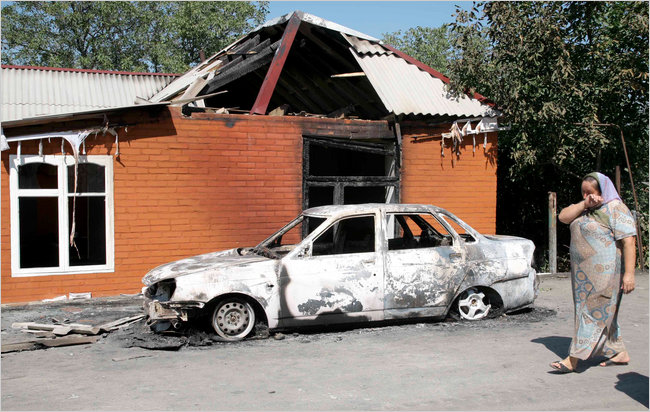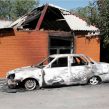
Attack on Kadyrov’s Home Village Damages Chechnya’s Image of Stability
Publication: Eurasia Daily Monitor Volume: 7 Issue: 159
By:

On August 29, Chechen President, Ramzan Kadyrov’s, home village Tsentoroi (aka Khosi-Yurt) was attacked by a group of militants. Initial reports said there were ten casualties among the attackers and two among Kadyrov’s forces (RIA Novosti, August 29). Russian official sources stated that five civilians were killed during the fighting, but Kadyrov claimed there were no casualties among the civilians in the village (www.kavkaz-uzel.ru, August 29). Later, the official number of casualties climbed to 12 among the militants and six among the government forces, along with 18 injured servicemen and seven injured civilians (www.kavkaz-uzel.ru, August 30).
The attack shattered the image of Kadyrov’s unshakeable rule in Chechnya, given that it was the first time his stronghold in Tsentoroi had come under attack in the past six years. Since 2000, six attempts have been made on Kadyrov’s life, two of them using suicide bombers. The previous attack on Tsentoroi took place in May 2004, a few days before Akhmad Kadyrov, Ramzan father and predecessor as president of Chechnya, died in a bomb explosion (www.voanews.com, August 30).
The government authorities’ helplessness in the wake of the attack was striking, with Kadyrov and Russian officials giving conflicting information about the number of attackers, losses and the overall course of events. Kadyrov claimed that the government had in fact knowingly allowed the militants to enter Tsentoroi in order to wipe them out (RIA Novosti, August 29). In his blog, however, Kadyrov wrote that Tsentoroi was attacked by militants early in the morning on August 29 and made no mention of the government’s attempt to trap them (https://ya-kadyrov.livejournal.com, August 29).
According to Kadyrov, there were about 15 attackers, 12 of whom were killed, with only the ones who made the video recording escaping. However, the militants’ website Kavkaz Center reported that three rebel detachments numbering about 60 fighters attacked Tsentoroi, targeting Kadyrov’s closest associates and burning down ten of their houses. Fifteen people among Kadyrov’s forces were killed, while the militants suffered three casualties and the whereabouts of two others remain unknown (www.kavkazcenter.com, August 29).
Earlier in August, Kadyrov claimed there were only 70 fighters left in Chechnya, including foreign mercenaries. In the wake of the attack on Tsentoroi, this figure appears to be even more doubtful. Later Kavkaz Center claimed that the militants employed the tactics of Afghanistan’s Taliban, with a group of fighters attacking an object and inflicting as much damage as possible with no intention of retreating. In Tsentoroi, there may have been up to ten such suicide fighters, according to the website (www.kavkazcenter.com, September 1). Official sources obliquely confirmed this information, claiming that seven out of the 12 slain attackers detonated explosives they had on them after they were wounded in the fighting (RIA Novosti, August 30).
Both Chechen officials and Kavkaz Center sources largely agree on who staged the attack. They do not mention Doku Umarov, but rather Aslambek Vadalov and his subordinates. Earlier in August, Umarov announced his resignation from the Caucasus Emirate leader’s position and appointed Vadalov as his successor. Later Umarov renounced his own move and declared he was going to stay in power. Some observers said the moves reflected a rift within the insurgency between the secular-leaning wing of Chechen fighters and the Islamist, pan-Caucasus wing led by Umarov.
On September 2, Kadyrov officially announced a reward of more than $300,000 for information about each of the insurgency leaders. Chechen commentators interpreted the move as an indicator of the government’s weakness. Conflicting information disseminated by Kadyrov’s administration contributes to the spread of rumors in Chechnya and distrust of official sources. Some say that the militants practically captured Tsentoroi for several hours and the government had to revert to using artillery and helicopters in order to drive them out. Civilians are still not allowed out of Tsentoroi, a village with more than 5,000 inhabitants, and allegedly under the threat of death they were warned not to talk about the siege and the damage that the militants inflicted. Local Chechens speak of heavy losses for Kadyrov’s image as the pacifier of the republic (www.kavkaz-uzel.ru, September 3).
Carnegie Endowment for International Peace expert, Thomas de Waal, said that the leader’s image in Chechnya is a very important factor that defines his public standing and credibility in the society. Kadyrov’s image was badly damaged as a result of the attack on his stronghold. Besides, according to de Waal, the attack would have been impossible if there were no rebel informants in the circles close to Kadyrov (www.voanews.com, August 30).
Kavkaz Center also reports that there have been vigorous attempts to find the possible rebel informants within Kadyrov’s entourage. People on Kadyrov’s side allegedly blamed the destabilizing incident on Isa Yamadaev’s return to Chechnya, as he and his people may have supplied important information to the militants. Massive interrogations are taking place in Tsentoroi (www.kavkazcenter.com, September 2). Earlier, on August 22, Isa Yamadaev met Kadyrov in Chechnya and announced an end to hostilities between Yamadaev’s clan and Kadyrov (Interfax.ru, August 22).
The brazen attack on Kadyrov’s stronghold village signifies first and foremost the level of control over information coming out of Chechnya. Killings of and threats against independent journalists and rights activists, and restrictions on media, have created a situation in which no one knows exactly what is going on in Chechnya. Kadyrov managed to convince most people that he controls the situation. Many see Kadyrov’s rule as the lesser evil, considering the bloodbath Chechnya underwent when the Russian army fought the pro-independence movement in the republic. Now, however, it appears that Kadyrov’s rule and the stability in Chechnya equated with it rest on very shaky ground and can plausibly be brought down any time.




